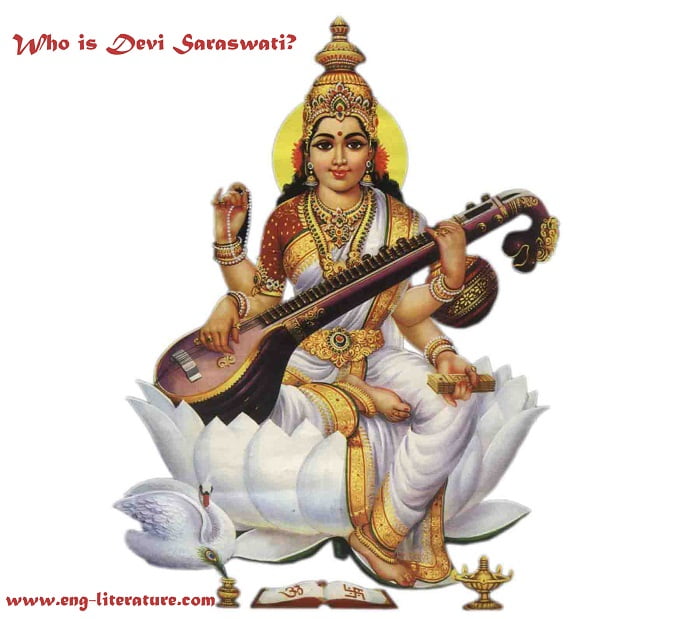
Devi Saraswati Facts
The real identity of Devi Saraswati, has been one of the most enduring enigmas and highly controversial of ancient Indian history. The Saraswati Puja is celebrated every year in almost all educational institutions. But only very few people hardly know who this Devi Saraswati is. Let us try to analyse those topics for better understanding our myth.
- The name Saraswati came from “saras”(meaning “flow”) and “wati” (meaning “she who has …”), i.e. “she who has flow” or can mean sara meaning “essence” and swa meaning “self”. So, Saraswati is symbol of knowledge; its flow (or growth) is like a river and knowledge is supremely alluring, like a beautiful woman. She is depicted as beautiful fair Goddess with Four arms, wearing spotless white saree and seated on white lotus. She is also known as “Sharada”, “Vani” and “Vagdevi” (both meaning “speech”).
- In the East Indian states of Bihar, West Bengal, Orissa: Saraswati is considered to be a daughter of Durgaalong with her sister Lakshmi and her brothers Ganesha and Karthikeya.
- In the Rigveda, Saraswati is a river as well as its personification as a goddess. In the post-Vedic age, she began to lose her status as a river goddess and became increasingly associated with literature, arts, music, etc. In Hinduism, Saraswati represents intelligence, consciousness, cosmic knowledge, creativity, education, enlightenment, music, the arts, eloquence and power. Hindus worship her not only for “academic knowledge”, but for “divine knowledge” essential to achieve moksha.
- In some Puranas (like Skanda Purana) she is daughter of Shiva (Shivaanujaa) and in some Tantras with Ganesha.However across India she is worshipped as the wife of Lord Brahma. In the Devi Mahatyam it mentions her as Brahmapatni. According to some sects Saraswati was born from the left body part of Vishnu when Vishnu was in his eternal sleep.
- Brahma discovered the melody of mantras in the cacophony of chaos. In his joy he named Saraswati, Vagdevi, goddess of speech and sound.
- According to Vedanta she is considered to be the feminine energy and knowledge aspect (Shakti) of Brahma, as one of many aspects of Adi Shakti.
- In the Devi Mahatmya, Saraswati is in the trinity of Maha Kali, Maha Lakshmi and Maha Saraswati.She is depicted as eight-armed. Her dhyāna shloka given at the beginning of the Fifth chapter of Devi Mahatmya is: Wielding in her lotus-hands the bell, trident, ploughshare, conch, pestle, discus, bow, and arrow, her lustre is like that of a moon shining in the autumn sky. She is born from the body of Gowri and is the sustaining base of the three worlds. That Mahasaraswati I worship here who destroyed Sumbha and other asuras.
- The goddess Saraswati is often depicted as a beautiful woman dressed in pure white often seated on a white lotus, which symbolizes that she is founded in the experience of the Absolute Truth. Thus, she not only has the knowledge but also the experience of the Highest Reality. She is mainly associated with the color white, which signifies the purity of true knowledge. Occasionally, however, she is also associated with the colour yellow, the colour of the flowers of the mustard plant that bloom at the time of her festival in the spring. She is adorned with simple jewels and gold, unlike the goddess Lakshmi; representing her preference of knowledge over worldly material things.
- Devi Saraswati is generally shown to have four arms, which represent the four aspects of human personality in learning: mind, intellect, alertness, and ego. Alternatively, these four arms also represent the 4 Vedas, the primary sacred books for Hindus. The Vedas, in turn, represent the 3 forms of literature: Poetry — the Rigveda contains hymns, representing poetry Prose — Yajurveda contains prose Music — Samaveda represents music.
- Devi Saraswati is shown to hold the following in her hands: A book, which is the sacred Vedas, representing the universal, divine, eternal, and true knowledge as well as her perfection of the sciences and the scriptures. A mālā (rosary) of crystals, representing the power of meditation and spirituality. A pot of sacred water, representing creative and purification powers. The vina, a musical instrument that represents her perfection of all arts and sciences. Saraswati is also associated with anurāga, the love for and rhythm of music which represents all emotions and feelings expressed in speech or music.
- A hamsa or goose is often located next to her feet. The sacred bird, if offered a mixture of milk and water, is said to be able to drink the milk alone. It thus symbolizes discrimination between the good and the bad or the eternal and the evanescent. Due to her association with the bird, Saraswati is also referred to as Hamsavahini, which means “she who has a hamsa as her vehicle”.
- In Hindu beliefs, great significance is attached to offering honey to this goddess, as honey is representative of perfect knowledge. Hymns dedicated to her include Saraswati Vandana Mantra.
Also Read: